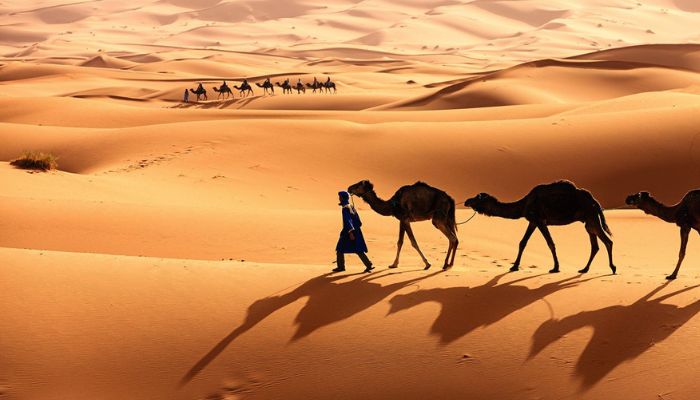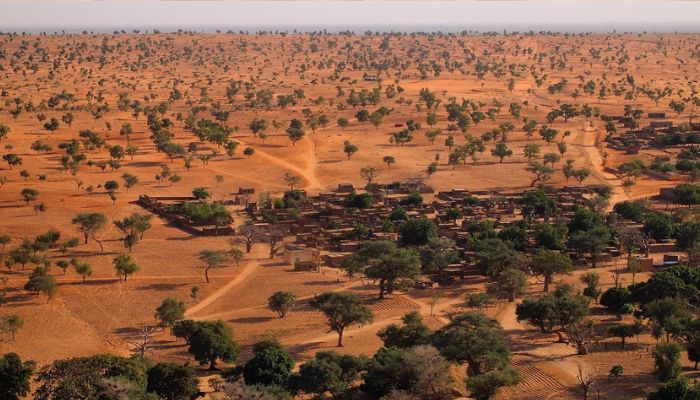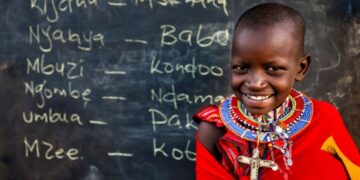Africa is home to some of the world’s most fascinating sceneries including deserts and rainforests. Interestingly, deserts in Africa make up one-third of the continent’s overall size. These locations possess some of the greatest landscapes and topographies that have been beautifully designed by nature.
While the general thoughts about deserts are mostly negative, African deserts actually present special environmental and archeological history dating millions of years. More so, these dry locations have served as homes to some unique African ethnic groups and wildlife.
Here are Some Deserts In Africa You Should Know
1. Sahara Desert

- Location: North Africa
- Length: 4,800km (3,000 mi)
- Width: 1,800 km (1,100 mi)
- Area: 9,200,000 km2
- Known for: Being the largest hot desert in the world
The Sahara desert is the largest desert on the African continent and the third-largest desert in the world with an area coverage of 9,200,000 square kilometers; amounting to 31% of Africa.
The name Sahara is of Arabic origin meaning ‘desert’ and it covers large parts of Algeria, Chad, Egypt, Libya, Mali, Mauritania, Morocco, Niger, Western Sahara, Sudan, and Tunisia.
In summer, temperatures in the Sahara desert can reach 50 °C in the daytime. This scorching temperature also spreads to the 12 countries in North Africa.
2. Kalahari Desert
- Location: Southern Africa
- Lenght: 4, 000 km (2,500 mi)
- Width: About 1, 600 km (1,000 mi)
- Area: 900,000 km2 (350,000 sq mi)
- Known for: A range of wildlife such as lions, hyenas, and antelopes
The Kalahari Desert which is located in the center of Southern Africa comprises most of Botswana, Namibia, and South Africa.
The name Kalahari is derived from the Tswana word Kgala, meaning a waterless place. More so, it is a semi-arid sandy savanna that extends 900,000 square kilometers.
3. Karoo Desert
- Location: Eastern Cape, Western Cape, and Northern Cape provinces, South Africa.
- Area: 750 km2 (290 sq mi)
- Known for: Containing the most plentiful selection of succulent plants in the world
The Karoo Desert is a semi-desert natural region in South Africa. The Karoo is split into 2 main regions; the Great Karoo and the Little Karoo.
There is no exact definition of what constitutes the Karoo. This is because its extent is not precisely defined. However, the desert is partly defined by its topography, geology, and climate. It is also defined by its low rainfall, arid air, cloudless skies, and extremes of heat and cold.
Unlike other deserts, Karoo witnesses an annual rainfall of between 50 and 250 mm. Some of its mountains can be 250 to 500 mm high. It also has underground water which can be tapped by boreholes, making permanent settlements and sheep farming possible.
4. Danakil Desert
- Location: Northeast Ethiopia, southern Eritrea, and northwestern Djibouti
- Length: About 570 km long
- Width: Varis from 80 to 400 km
- Area: 136,956 km2 (52,879 sq mi)
- Known for: Volcanoes and extreme heat
The Danakil Desert is a desert is located in northeast Ethiopia, southern Eritrea, and northwestern Djibouti. It is inhabited by a few Afar people, who engage in salt mining.
The area is known for its volcanoes and extreme heat, with daytime temperatures surpassing 50 °C. It is also one of the lowest and hottest places on planet Earth.
5. Chalbi Desert
- Location: Northern Kenya
- Length: 110 km
- Width: 10 to 20 km wide
- Area: 1,000 km2
- Known for: Housing the largest wind farm in Africa
The Chalbi Desert is a small desert that is located in northern Kenya, near the border with Ethiopia, east of Lake Turkana.
The name Chalbi is derived from the language of the Gabbra people, meaning “bare salty area.” The desert is known to be decorated with a selection of rocks and clay formations.
The Gabbra pastoralists live around the Chalbi desert region and they herd goats, cattle, and camels. Other pastoralists like Rendille, Dasancech, and Turkana also reside in this region.
6. Naib Desert
- Location: Southern Africa, Namibia, and Angola
- Length: 1,600 km (990 mi)
- Width: 50–160 km (31–99 mi)
- Area: 160,000 km2 (62,000 sq mi)
- Known for: Being a UNESCO World Heritage Site
The name Namib is of Khoekhoegowab origin and means “vast place”. It stretches for more than 2,000 kilometers (1,200 mi) along the Atlantic coasts of Angola, Namibia, and South Africa. It also extends southward from the Carunjamba River in Angola, through Namibia, and to the Olifants River in Western Cape, South Africa.
The Namib Desert is believed to be the oldest desert in the world, dating back to around 80 million years ago.
The desert is almost completely uninhabited by humans except for several small settlements and indigenous pastoral groups which include Ovahimba, Obatjimba Herero, and Topnaar Nama.
7. Guban Desert
- Location: Northwestern Somalia
- Length: 1,500 km (930 mi)
- Width: Varies from 12km in the west to 2 km in the east
- Area: Estimated to be 7000 km²
The Guban Desert refers to the ‘narrow burnt land.’ It stretches through the easternmost tip of the Northern Somalian coast, between the cities of Zeila and Berbera.
The desert is known to be hot and dry. It is also home to a system of sandy seasonal watercourses and some steppe vegetation.
SEE ALSO: Thank You in Swahili, Zulu, And 50 Other African Languages
8. Nyiri Desert
- Location: Southern Kenya
- Area: 1,420,236 square miles (3,678,394 square km)
- Known for: Baobab trees that are as old as two thousand years
The Nyiri desert is also known as The Nyiaka or Taru Desert. It is seated east of Lake Magadi and between Amboseli, Tsavo West, and Nairobi National Parks.
The desert is considerably dry and its aridity is caused by the rain shadow of mount Kilimanjaro. Parts of the desert have dense growths of small trees, many of them thorny and some of them poisonous.
9. Grand Bara Desert
- Location: Southern Djibouti
- Length: 56.34 kilometers
- Area: 103 km2 (40 sq mi)
- Known for: Grand-Bara desert marathon
The Grand Bara Desert is the remains of dried-up lake beds located in Djibouti. This desert is composed of huge sand flats that are broken up by sparse desert grasses and shrubs. There is also a select number of large mammals living in this region. Some of them are Beira antelopes, Dorcas gazzele and Salt’s dik-dik.
10. Lompoul Desert
- Location: Senegal
- Area: About 18 km2 (7 sq mi)
- Known for: Being a popular tourist attraction in Senegal
The Lompoul desert is the smallest desert in Africa and is located in the northwest region of Senegal between Dakar and Saint-Louis.
It is popular for possessing orange sand dunes forming a landscape that is more akin to those of the Sahara and Mauritania than those of the surrounding area of Senegal.
11. Ténéré

- Location: South central Sahara
- Area: 400,000 km2 (200,000 sq mi)
- Elevation: 430 m (1,410 ft)
- Known for: Aïr and Ténéré Natural Reserve.
The Ténéré is a desert region comprising a vast plain of sand that stretches from northeastern Niger into western Chad.
Ténéré means desert in the Tuareg language which is spoken by the Tuareg Berbers situated in large parts of Mali, Niger, Algeria, Libya, and Burkina Faso with a few speakers in Chad.
The desert has a hot climate that is typical of the large Sahara Desert. The climate is hyper-arid, extremely hot, sunny, and dry year-round making it very difficult for any plant life. The average high temperatures here are above 40 °C.
Ténéré is very sparsely populated by the Tuareg, Agadez and Hausa Merchants.
12. Libyan Desert
- Location: Libya
- Length: 1,000 km
- Width: 1,100 km
- Area: 1,300,000 square kilometres (500,000 sq mi)
- Known for: Being the site of the missing World War II aircraft Lady Be Good
Also called the western desert, the Libyan Desert is a geographical region filling the northeastern Sahara Desert, from eastern Libya to the Western Desert of Egypt and far northwestern Sudan. Like most of the Sahara, the Libyan desert is primarily sand and hamada or stony plain.
Libyan Desert is scarcely populated except for the modern settlements at oases of the lower Cyrenaica region in southeastern Libya. The indigenous population there are the Bisharin tribe, Mahas, and Berber.
The desert is said to be one of the least hospitable regions on Earth because of its temperature which averages 50 °Cand above during the daytime, though this drops rapidly at night.
13. Bayuda Desert
- Location: Northern Sudan
- Area: 100,000 km2
- Known for: Gold mining
The Bayuda Desert is located in the eastern region of the Sahara Desert, spanning through northeastern Sudan, north of Omdurman, and south of Korti. It has for centuries been the home of a number of Bedouin tribes.
One unique thing about the desert is that gold mining occurs there between the months of October to March.
The location is also a route for travelers, pastoralists, and merchants going through northern Sudan.





















Discussion about this post